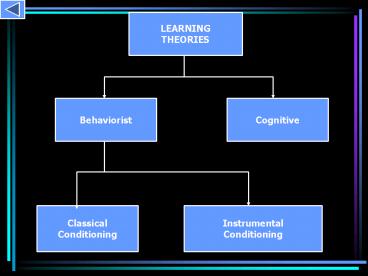Habitual Decision Making PowerPoint PPT Presentation
1 / 24
Title: Habitual Decision Making
1
LEARNING THEORIES
Behaviorist
Cognitive
Classical Conditioning
Instrumental Conditioning
2
Behaviorist/Associative Learning
- Learn to develop automatic Response to a Stimulus
(stimulus-response learning) - This type of learning occurs through forming
associations between a new stimulus (CS) and an
old stimulus (US)
3
Instrumental (Operant) Conditioning
- Whether you perform a behavior again depends on
what happened when you performed that behavior in
the past - Skinners bird experiment
- Suppose there are two buttons -- bird can choose
button A or button B (so two different behaviors) - Choice of A followed by food (reinforcer/reward)
- Choice of B followed by shock (punishment)
4
Instrumental (Operant) Conditioning
- Over time, Button A will be chosen automatically!
- Button B will be avoided automatically!
5
Learning has taken place
- Learning results in automatic response to a
stimulus (avoiding or choosing button) - Again stimulus-response learning
6
Learning through Instrumental Conditioning
- Reward for behavior increases chances of behavior
- Punishment for behavior decreases chances of
behavior
7
Instrumental Conditioning also involves CS-US
association
- Classical Conditioning
- Cowboy --- Liked
- Marlboro --- Liked (US, CS, CR??)
- Instrumental conditioning
- Food ------- Like
- Button ------ Hitting button
- US, CS, CR??
8
How can Marketers use IC?
- Instrumental conditioning is used to influence
behaviors - What behavior do you want consumers to do??
- How?
- Rewards?
- Punishments?
9
Marketing Example of IC
- Buy Brand ---- Get Discount ---- Buy Brand again
- What is US, CS, CR?
10
Marketing Example of IC
- Discount --------- Like
- Brand -------------- Buy Again
11
If Successful.Instrumental Conditioning
- Can produce automatic buying and repurchase of
your brand (just like bird will automatically hit
button A and not B) - Automatic repurchase (without consideration of
other alternatives) what type of decision
making?
12
Issues in Instrumental Learning
- Reinforcement Schedules
- Continuous schedule reward every time behavior
is performed - partial schedule reward sometimes
- Example giving discount/coupons etc. after
purchase - Continuous reinforcement discount every time
- Partial schedule discount only occasionally.
13
Continuous vs. Partial Schedule
- Which produces faster learning? (I.e., which one
will make the consumers learn the brand
discount association faster?) - Which produces more permanent learning (I.e.,
which one will lead to more long-term positive
effects on consumers desired behavior buying
your brand?) - Airlines??
14
Issues in Instrumental Conditioning
- Reinforcement vs. Punishment
- Instrumental Conditioning occurs when behavior is
followed by reinforcement or punishment
15
Reinforcement
- Reinforcement rewarding a behavior to increase
future possibility of that behavior - Two Types of Reinforcement
16
Two types of Reinforcement
- Positive reinforcement (behavior followed by good
consequence e.g., good after sales service) - Here, Reward Getting something positive
because of behavior - Negative reinforcement
- Negative State First then Behavior then
Removal of Negative Stage - e.g., taking medicine for headache
- Here, Reward removal of negative state
because of behavior
17
Punishment
- Punishment Punishing a behavior to decrease
future possibility of that behavior - behavior followed by negative consequence e.g,
bad after sales service - Note Punishment is different from Negative
Reinforcement (even though the words sound
similar!) - Negative Reinforcement increases chances of
behavior - Punishment decreases chances of behavior
18
Reinforcement and Punishment
- Punishment can be used by marketer
- example???
19
Issues in Instrumental ConditioningShaping
- Shaping Reinforcing a behavior at every step
- So break down an overall behavior into its
component parts, and reward each component, so
that the overall behavior is learnt - Bird example?
20
Shaping Marketing Example
- Suppose you own a car dealership (showroom). You
want to make a consumer buy a car from your
showroom - Can you think of how you can use shaping to do
this? (hint start from the consumer entering
your showroom)
21
Other Issues...
- Discriminative Stimulus Stimulus that occurs in
the presence of a reinforcer but not in its
absence - Example buy Reebok---satisfaction (reward)
- Learn to associate the brand name Reebok with
the reinforcer/reward (satisfaction) - Brand name discriminative stimulus
- Helps to discriminate (differentiate) between
different stimuli - Reebok gives satisfaction, but Nike gives
dissatisfaction - I learn to discriminate based on brand name
22
Stimulus Discrimination and Stimulus
Generalization
- Stimulus Discrimination
- Using a discriminative stimulus to differentiate
between different stimuli (Nike vs. Reebok) - Can also use discriminative stimulus to treat
different items as similar (Stimulus
Generalization) - Reebok shoes give me satisfaction
- So I try Reebok clothing also, just based on
brand name - Here brand name is being used to treat different
items as similar
23
Classical vs. Instrumental
- Similarities
- both behavioral learning
- number of trials increases learning
- Differences
- passive learning vs. active learning
- Instrumental conditioning you have to perform
an action before any learning can occur (behavior
consequence learning) - Classical conditioning your action is not
needed. Learning will occur if the US and CS are
presented together to you by some external agent - Example (watching advertising)
24
For Next Class
- For next class
- Extinction and Forgetting pg. 114-118
- Habit pg. 122-133

